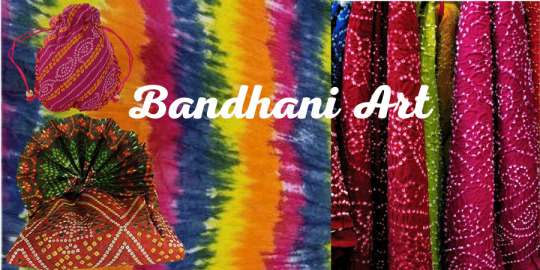#rasmandala
Text

THE COVETED BANDHINI ART
What comes to your mind when the states of Rajasthan and Gujarat are mentioned? The vast stretches of Thar Desert… The mighty Aravali range… Sabarmati River flowing peacefully… Majestic forts and palaces… The energetic dandiya raas… Sumptuous vegetarian thalis… And the vivacious Bandhani or Bandhej sari.
The word ‘Bandhani’ comes from the Sanskrit word ‘Bandhan’ which means ‘to tie’. It is the traditional Indian ‘tie and dye‘ art (resist-dyeing technique) that results in colourful and interesting patterns on the cloth. The first Bandhani sari was perhaps worn at the time of Bana Bhatt`s Harshacharita for the occasion of a royal wedding. The patterns of this art form were also seen in the 6th century paintings in Ajanta. Bandhani work was started by the Khatri community of Gujarat. The major cities in Rajasthan like Jaipur, Sikar, Bhilwara, Udaipur, Bikaner, Ajmer, and Jamnagar in Gujarat are well known producers of Bandhej saris, dupattas, odhnis and pagdis.
Earlier, dyes were extracted from natural plant sources like roots, flowers, leaves, and fruits. But today, besides these natural dyes, easy to use and permanent synthetic colours are also used in tying and dyeing process.
The process involved in this art is completely design oriented. The fabric to be tied and dyed is cleaned thoroughly and then bleached. Bleaching ensures that the fabric is free from any residual colour and picks the new colour instantly. After the cloth is dried, a very small portion of the material is raised and tied into knots using a cotton thread. The knotted material is then dyed in a light colour. The knotted parts retain the original colour, and the rest of the fabric gets dyed. Then these lighter dyed portions are knotted, and the material is soaked again in another dye. This process is repeated for different colours.
Elaborate motifs and designs like flowers, jaals, bells and creepers are made using this tie and dye technique. The knots are placed in clusters each having a different name:
• Ekdali: single dot
• Tikunthi: three dots that make circles and squares
• Chaubundi: four dots
• Satbandi: dots in groups of seven
• Boond: small dot with a dark center
• Kodi: tear or drop-shaped pattern
• Dungar Shahi or Shikargah: a mountain-like pattern
• Jaaldar: web-like pattern
• Beldaar: vine-like pattern
• Laddu Jalebi: swirling pattern
• Leheriya: wave-like pattern
DIFFERENT TYPES OF BANDHANI SARIS:
GHARCHOLA
The most popular and finest of Bandhani from Gujarat is the Gharchola. Golden threads are woven into the fabric that needs to be used for tie and dye. Considered auspicious, gharcholas are exclusively designed for brides making it the most important addition to her wedding trousseau. Gharcholas were earlier made with cotton fabric but with changing times, silk has successfully taken over the humble cotton. They are mostly designed in bright colours like orange, red and green.
AMBADAAL
Another common pattern seen in bandhej is the Ambadaal or the mango branch wherein the fabric is designed entirely in a jaal-like pattern.
BAVANBAGH
Bavanbagh means 52 gardens wherein the fabric is designed in 52 segments each with a small bandhani pattern.
RASMANDALAS
It is a circular pattern showcasing the rasleela or the dancing gopis, done intricately using a tie and dye method.
CHANDROKHANI
The word chandrokhani means figures of moon. An attire for a newlywed bride, this bandhej sari in dark base and circular moon pattern symbolizes a comparison between the moon and the bride.
Over the years bandhej patterns and garments have evolved tremendously. Earlier only saris, dupattas and traditional clothing were made using this method. But to meet the modern demands, items of home décor like pillow and cushion covers, napkins, tablecloths, bed sheets, etc are also made with this technique. Recognising the exclusive tie and dye bandhani art, Jamnagari bandhej was included in the Geographical Indication (G.I.) registry in the year 2016.
Indian handicrafts online
#Bandhini#bandhej#bandhini sari#bandhej sari#gharchola#tie and dye#resist dyeing#ambadaal#bavanbagh#rasmandala#chandrokhani
0 notes